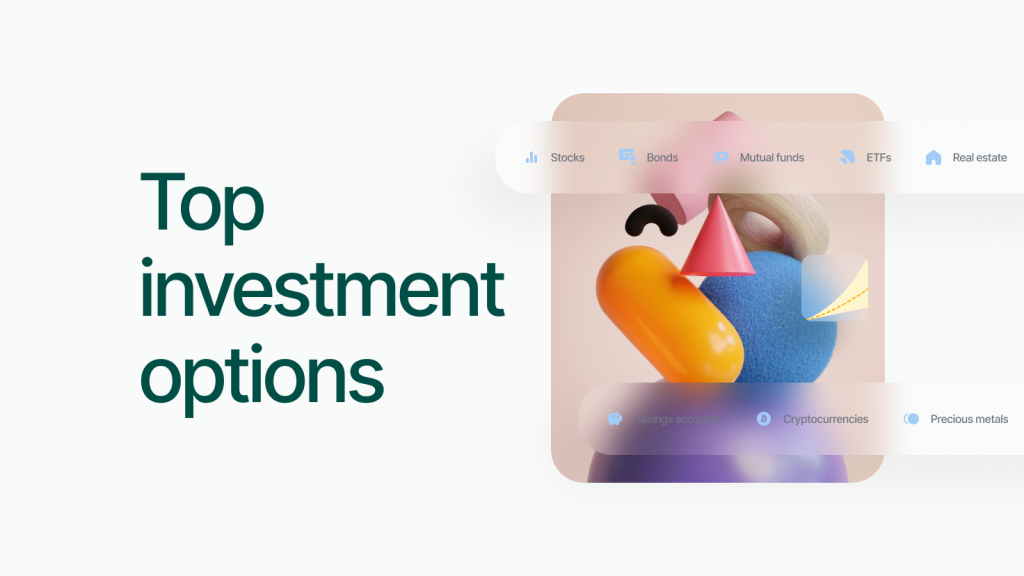Investing can be a powerful way to build wealth and achieve financial goals. At the same time, the myriad of options available can be overwhelming. This guide will walk you through various investment options for 2025, highlighting their benefits, risks, and how to choose the right one based on your financial goals and risk tolerance. Whether you’re looking for income-generating investment options or high-growth opportunities, understanding the choices available to you can help you make informed decisions.
Popular investment options
1. Stocks
- Benefits: Stocks offer the potential for high returns over the long term, as you invest in companies that may grow and increase in value. They also provide dividends, which can be a source of passive income. Many investors consider stocks as one of the best investment options due to their historical performance and potential for growth.
- Risks: The stock market is volatile, and prices can fluctuate significantly in the short term. This volatility can lead to substantial losses if you need to sell during a downturn. While stocks can offer high rewards, they also come with high risks.
- Best for: Investors with a higher risk tolerance who are looking for growth and are willing to endure market fluctuations. Stocks can be suitable for both long-term investment options and short-term investment options depending on your strategy. For beginners, investing in stocks through mutual funds or ETFs can be a safer way to get started. There are various stock market investment options available that can cater to different risk appetites and financial goals.
2. Bonds
- Benefits: Bonds are generally considered low-risk investment options, offering steady income through interest payments. They act as a stabilizing force in a diversified portfolio and are often used to balance riskier assets like stocks. Bonds can be particularly appealing for those looking for safe investment options and predictable returns.
- Risks: Bonds are subject to interest rate risk. When interest rates rise, bond prices typically fall. Additionally, there is credit risk, where the bond issuer may default on payments. While bonds are less volatile than stocks, they still carry some risk, especially in a fluctuating interest rate environment.
- Best for: Conservative investors seeking regular income and stability. Bonds are ideal for those who prioritize preserving capital over seeking high returns. They are often recommended for retirement investment options, providing a reliable source of income during retirement years.
3. Mutual fund
- Benefits: Mutual funds pool money from many investors to buy a diversified portfolio of stocks, bonds, or other assets. This diversification reduces risk and is managed by professional fund managers. Mutual funds are considered among the best investment options for beginners due to their ease of use and built-in diversification.
- Risks: Mutual funds charge management fees, which can eat into returns. They can also sometimes underperform the market due to management decisions. It’s important to research and choose funds with a good track record and reasonable fees.
- Best for: Investors looking for a hands-off approach to investing. Mutual funds suit those who prefer professional management and want to invest in a diversified investment option without selecting individual stocks or bonds. They are also suitable for both long-term and short-term investment options, depending on the specific fund’s strategy. Exploring various mutual fund investment options can help investors find the right funds that align with their financial goals and risk tolerance.
4. Exchange-traded funds (ETFs)
- Benefits: ETFs offer diversification similar to mutual funds, but trade like stocks on an exchange. They typically have lower fees and provide the flexibility to buy and sell throughout the trading day. ETFs can cover various asset classes, including stocks, bonds, and commodities, making them a versatile investment option for beginners and experienced investors alike.
- Risks: While generally lower in cost, ETFs still carry market risk. The value of the ETF can fluctuate based on the performance of the underlying assets. Additionally, some ETFs may have lower liquidity, which can affect the ease of buying or selling shares.
- Best for: Investors seeking a balance between mutual funds and individual stocks, with a focus on cost efficiency and flexibility. ETFs are ideal for those looking for a diversified investment option and can be tailored for both long-term investment options and short-term investment options. They are also a great choice for those interested in high-yield investment options, depending on the specific ETF’s focus.
5. Real estate
- Benefits: Real estate investments can provide rental income and the potential for property value appreciation. Real estate is a tangible asset, offering a sense of security and stability. Investing in real estate can be a long-term investment option that acts as a hedge against inflation.
- Risks: Real estate requires significant capital and is relatively illiquid, meaning it can be challenging to sell quickly. Market conditions, property management issues, and maintenance costs can also impact returns. Conduct thorough research and consider location, market trends, and property condition.
- Best for: Investors looking for long-term investments and income. Real estate is ideal for those who want a tangible asset and are prepared to handle the responsibilities of property management. It can be a part of a diversified investment option strategy, particularly for those seeking real estate investment options like rental properties, commercial real estate, or real estate investment trusts (REITs).
6. Savings accounts, fixed-term deposits, Money Market funds (MMF)
- Benefits: These are among the safest places to put your money, with minimal risk to your capital. Savings accounts offer easy access to your money, making them highly liquid, with minimal restrictions on deposits and withdrawals. Fixed-term deposits, while less liquid, typically offer higher interest rates in exchange for locking your money away for a set period, resulting in better returns compared to regular savings accounts. Money Market Funds (MMFs) offer slightly higher returns than savings accounts and remain relatively liquid, providing a balance between liquidity and return.
- Risks: The primary risk is that the returns may be low, especially in a low interest rate environment, which could result in your money not keeping pace with inflation. Withdrawing money from fixed-term deposits before maturity can incur penalties, reducing your overall returns. While generally low-risk, MMFs do have some exposure to market fluctuations, which can affect returns.
- Best for: Ultra-conservative investors and those needing liquidity for emergency funds. These options are ideal for those prioritizing capital preservation over high returns. They are also suitable for short-term financial goals where maintaining principal is crucial.
7. Cryptocurrencies
- Benefits: Cryptocurrencies offer the potential for high returns and diversification as digital assets. They operate on decentralized platforms using blockchain technology, which can provide greater security and transparency. Cryptocurrencies can be a part of a diversified portfolio and are popular as a high-yield investment option.
- Risks: Cryptocurrencies are extremely volatile and come with a high risk of loss. Regulatory changes, security issues, and market sentiment can significantly impact their value. Stay informed about the market and use secure, reputable platforms for transactions.
- Best for: Speculative investors with high risk tolerance and an interest in emerging technologies. Cryptocurrencies are suitable for those looking to diversify their investments and potentially earn high returns. They should be considered an alternative investment option and used as a small part of a diversified portfolio to mitigate risk.
8. Precious metals
- Benefits: Investments in precious metals like gold and silver can act as a hedge against inflation and economic uncertainty. They are considered safe-haven assets during market volatility. Precious metals are tangible assets that retain intrinsic value over time, making them a reliable store of value.
- Risks: Precious metals do not generate income and can be volatile in price. They may also incur storage and insurance costs. Market demand and geopolitical factors can significantly influence their prices, leading to potential fluctuations.
- Best for: Investors seeking to diversify their portfolio and protect against market downturns and inflation. Precious metals can be a part of a balanced investment strategy, particularly for those looking for low-risk investment options that provide stability during economic uncertainty.
How to choose the right investment option
1. Assess your financial goals
- Identify short-term and long-term goals, such as buying a house, funding education, or retirement.
- Determine the amount of money needed and the time frame to achieve these goals. This helps in selecting investments that match your objectives.
2. Evaluate your risk tolerance
- Consider how much risk you are willing and able to take. Your financial situation, investment experience, and comfort level with market fluctuations play an important role.
- Understand the potential for losses and how it aligns with your financial situation and goals.
3. Consider your investment horizon
- The length of time you plan to invest will impact your choice of investments. Longer horizons can typically handle more risk, while shorter horizons should focus on capital preservation.
- For example, younger investors might focus on growth stocks, while those nearing retirement may prefer bonds or income-generating assets.
4. Diversify your portfolio
- Spread your investments across various asset classes to reduce risk. Diversification can help mitigate the impact of poor performance in any single investment.
- Consider a mix of high-risk and low-risk investments based on your risk tolerance. Diversification can include stocks, bonds, real estate, and alternative investments.
5. Stay informed and review regularly
- Keep up with market trends and economic indicators to make informed decisions. Staying educated about your investments can help you react appropriately to market changes.
- Review your portfolio periodically and adjust as needed to stay aligned with your goals. Rebalancing ensures that your portfolio maintains the desired risk level and investment mix.
To dive deeper into specific investment topics, check out these related articles:
- What are ETFs?
- What is crowdfunding?
- What is passive real estate investing?
- Setting financial goals
- Value investing
- Alternative investments
By understanding and comparing different investment options, you can make informed decisions that align with your financial goals and risk tolerance, setting you on a path toward financial success in 2025 and beyond.
Investing wisely involves balancing risk and reward, staying informed, and regularly reviewing your strategy so that it meets your evolving needs.
Disclaimer:
This is a marketing communication and in no way should be viewed as investment research, investment advice, or recommendation to invest. The value of your investment can go up as well as down. Past performance of financial instruments does not guarantee future returns. Investing in financial instruments involves risk; before investing, consider your knowledge, experience, financial situation, and investment objectives.

